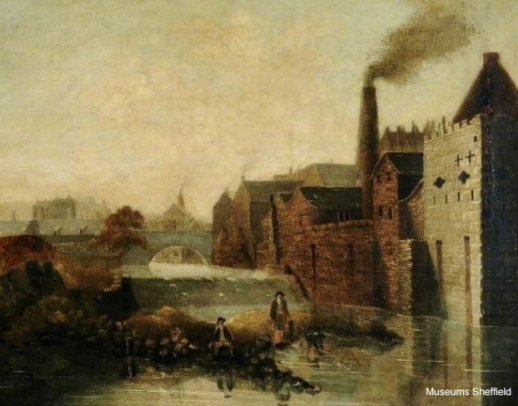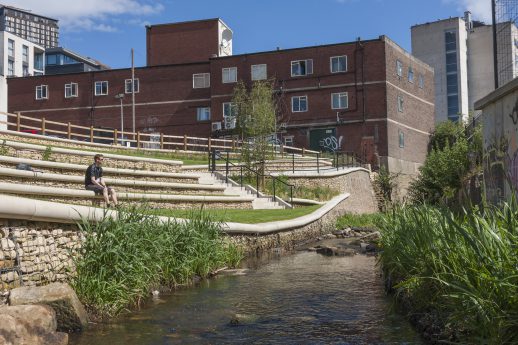Words: Simon Ogden
If Sheffield residents were curious about the existence of hidden rivers coursing beneath their feet they could head to an unlikely place to check one of them out last week – the car park of Decathlon on Eyre St on the edge of the City Centre – and many did!
Although the collapse of a section of the sports retailer’s car park was referred to in the media as a ‘sinkhole’, this incident tells us far more about the city’s recent history – and points a way forward for its mysterious, fascinating but often hidden waterways.
The hole had actually appeared due to the collapse of a concrete slab culvert over the River Porter, probably built to support a factory. As we’ve seen elsewhere in the city, culverts created for such purposes only have a certain shelf-life (this one seems to have been built in the 1940s) and many are now reaching their structural sell-by date.
But, stare a little bit deeper into this now de-culverted section of the Porter, and you can see Sheffield’s history up close, but also, get a tantalising idea of its future. This is the same river which forms the focus of the much loved Endcliffe, Bingham and Forge Dam parks.
How many people have stood on Platform 1 at Sheffield railway station, not realising that Sheffield’s Porter Brook joins with the flow of the River Sheaf in the darkness below, elevated on massive Victorian stone tunnels?
The Sheaf and the Porter flow in culverts (apart from a brief and inaccessible appearance next to the Digital Campus on Sheaf St – the clue is in the name) all the way to the River Don at Castlegate, but not before they pass through the Megatron – a culvert so large and impressive, it has featured on a list if the most famous caves in the UK.
Culverts were constructed at a time when most of our urban rivers were dirty, noxious and devoid of life. At the time this was seen as an improvement.
Along the 10km of the Porter Brook, there are about 1 km of culverts mostly in the City Centre where the latest sinkhole has appeared. This means, incredibly to some, that almost 10 per cent of the river is hidden.
This area was once at the heart of Sheffield’s steel and industrial beginnings powering flourmills, cutlery, steel and lead factories but is now being reinvented as the Cultural Industries Quarter – a place of education, innovation and city living. In this new era the hidden rivers are acquiring a new significance as a rich restored wildlife habitat, an important element of preparation for climate change and as an attraction for investment.
So whilst it is understood that Decathlon’s first priority will be to get their store and car park back in safe operation, members of the Waterways Strategy Group, which I chair, would be keen to talk with them about options for repair which make more of this ‘hidden river’ for people and wildlife and also improve flood resilience. This could include elements of re-naturalising, access for fishing or kayaking, and light wells for fish passage.
Just around the corner from Decathlon, the City Council, in conjunction with the Environment Agency and the Wild Trout Trust, has turned a crumbling car park into a fantastic pocket park, where people now have picnics and escape the demands of city life for a few moments.
People can paddle in the Porter, and trout have been frequently spotted in its waters. Students at the new Shoreham St University Technical College are among its most frequent users. This followed the removal of a similar collapsing culvert over the Porter, which has shown how the river bank can be restored to become a pleasant park and eventually a green corridor with reduced flood risk.
It’s been a remarkable transformation, and an award-winning one too – last year, the Porter Brook park won the ‘contribution to the built environment’ prize at the 2016 Living Waterways Awards, organised by the Canal and River Trust – and which will eventually form part of a city centre walk which extends from the station to St Mary’s.
But it has also added significant value to the site next to it .
The park, and a similar one on the banks of the Don at Nursery Street, have been created through the council’s City Centre Breathing Spaces programme, using money contributed under planning rules by developers as well as from the Environment Agency (EA). Further downstream, the council and EA are planning to restore more of the Porter near to the Station and open up the River Sheaf in Castlegate at the site that gave the city its name.
The proposal – called ‘Putting the Sheaf back into Sheffield’ and recently featured on The BBC’s The One Show – involves taking the roof off an underground culvert and bringing the waterway back into the open, surrounded by grass, flowers, trees and seating. Beyond that the progressive reclamation of the River Don is also continuing and the return of the North Atlantic Salmon to spawn in the Don and its tributaries is now only a few years away thanks to the Living Don Project.
The long-standing ambition of the WSG of reconnecting the city centre with its waterways – the Canal, and Rivers Don, Porter, and Sheaf, is now achievable. Every unexpected opportunity should be seized and made the most of.
Simon’s top three hidden Sheffield rivers:
1. The Lower Sheaf – glorious in Millhouses Park it largely disappears from view from Granville Square
2. The lower Porter Brook – the jewel of the Porter Valley Parks becomes an invisible drain below Frog Walk but has been revealed again at Matilda St
3. The Car Brook – flows from Manor Top to the Don at Brightside Weir through the Woodthorpe and Carbrook Ravines and Bowden Housesteads Wood before disappearing under Darnall and Attercliffe.

